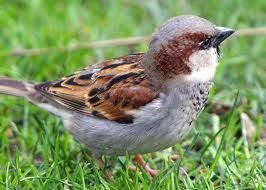
Scientific Name: Passer domesticus
LifeTime:3 years
Kingdom:Animalia
Phylum: Chordata
Class: Aves
Family: Passeridae
Genus: Passer
The plumage of the house sparrow is mostly different shades of grey and brown. The sexes exhibit strong dimorphism: the female is mostly buffish above and below, while the male has boldly coloured head markings, a reddish back, and grey underparts.[8] The male has a dark grey crown from the top of its bill to its back, and chestnut brown flanking its crown on the sides of its head. It has black around its bill, on its throat, and on the spaces between its bill and eyes (lores). It has a small white stripe between the lores and crown and small white spots immediately behind the eyes (postoculars), with black patches below and above them. The underparts are pale grey or white, as are the cheeks, ear coverts, and stripes at the base of the head. The upper back and mantle are a warm brown, with broad black streaks, while the lower back, rump and upper tail coverts are greyish brown.[10] Detail of the wing of a male The male is duller in fresh nonbreeding plumage, with whitish tips on many feathers. Wear and preening expose many of the bright brown and black markings, including most of the black throat and chest patch, called the "bib" or "badge".[10][11] The badge is variable in width and general size, and may signal social status or fitness. This hypothesis has led to a "veritable 'cottage industry'" of studies, which have only conclusively shown that patches increase in size with age.[12] The male's bill is black in the breeding season and dark grey during the rest of the year.[3] Heads of a male (left) and an immature or female (right) The female has no black markings or grey crown. Its upperparts and head are brown with darker streaks around the mantle and a distinct pale supercilium. Its underparts are pale grey-brown. The female's bill is brownish-grey and becomes darker in breeding plumage approaching the black of the male's bill.[3][10] Juveniles are similar to the adult female, but deeper brown below and paler above, with paler and less defined supercilia. Juveniles have broader buff feather edges, and tend to have looser, scruffier plumage, like moulting adults. Juvenile males tend to have darker throats and white postoculars like adult males, while juvenile females tend to have white throats. However, juveniles cannot be reliably sexed by plumage: some juvenile males lack any markings of the adult male, and some juvenile females have male features. The bills of young birds are light yellow to straw, paler than the female's bill. Immature males have paler versions of the adult male's markings, which can be very indistinct in fresh plumage. By their first breeding season, young birds generally are indistinguishable from other adults, though they may still be paler during their first yea
he house sparrow (Passer domesticus) is a bird of the sparrow family Passeridae, found in most parts of the world. It is a small bird that has a typical length of 16 cm (6.3 in) and a mass of 24–39.5 g (0.85–1.39 oz). Females and young birds are coloured pale brown and grey, and males have brighter black, white, and brown markings. One of about 25 species in the genus Passer, the house sparrow is native to most of Europe, the Mediterranean Basin, and a large part of Asia. Its intentional or accidental introductions to many regions, including parts of Australasia, Africa, and the Americas, make it the most widely distributed wild bird. The house sparrow is strongly associated with human habitation, and can live in urban or rural settings. Though found in widely varied habitats and climates, it typically avoids extensive woodlands, grasslands, and deserts away from human development. It feeds mostly on the seeds of grains and weeds, but it is an opportunis